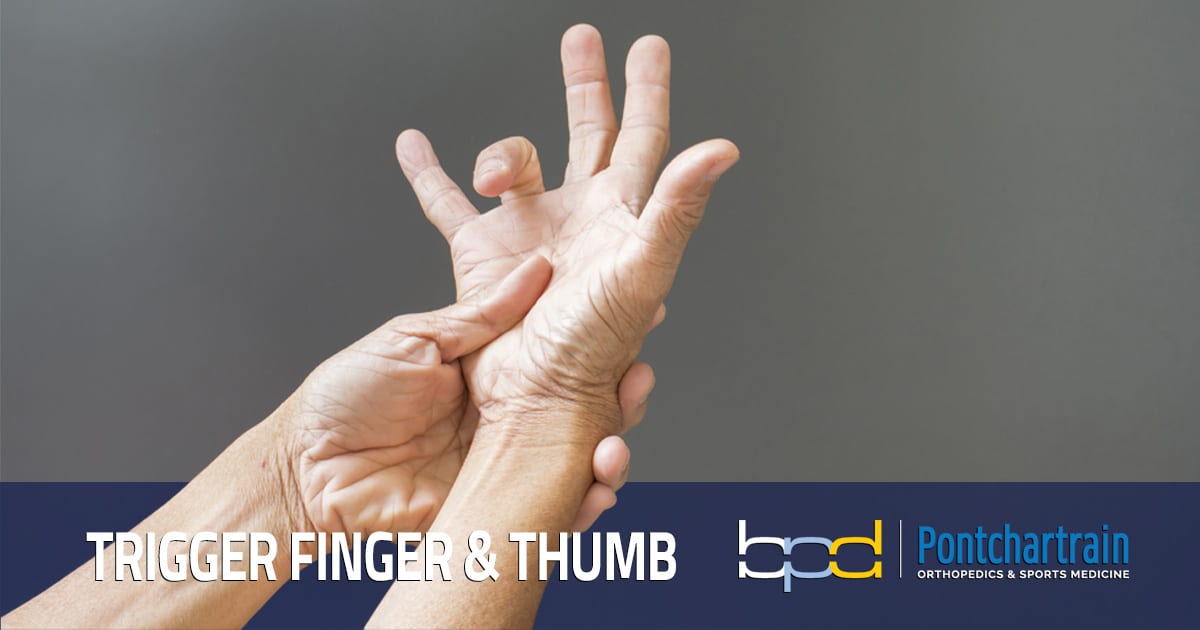
Trigger finger or trigger thumb – also known as stenosing tenosynovitis – are painful conditions that can make a digit catch or even lock in place. It happens when the sheaths around our tendons become irritated and swollen, making it harder for the tendons to slide easily. Nodules can also form on the tendon itself, halting the pulley motion needed for every-day movement.
As the issue worsens, sufferers may have stiffness when bending the finger or thumb, or hear popping or snapping sounds during every-day movement. Eventually, the situation can worsen to the point that the digit takes a shape very much like squeezing a trigger. In the following blog post, we’ll discuss the condition, how it’s diagnosed and typical treatment options.
“Trigger finger is more common in women than in men, and typically strikes those between 40 and 60.”Brandon P. Donnelly, MD
What is Trigger Finger?
Tendons connect bones to our muscles, allowing movement. These tendons are protected by a covering called a sheath. When that sheath becomes inflamed, a condition known as trigger finger can occur.
Trigger finger can happen in one or more digits, though the ring finger is often most affected. The condition is typically seen in people who have jobs or hobbies that require repetitive strenuous motion – especially frequent grasping or gripping, like farmers, musicians and industrial or factory workers.
Trigger finger is more common in women than in men, and typically strikes those between 40 and 60, but people of any age or occupation can be impacted. Those suffering from osteoarthritis, gout, renal disease, rheumatoid arthritis or diabetes are at a higher risk.
How is Trigger Finger Diagnosed?
Diagnoses are fairly routine, since those with trigger finger have many outwardly observable symptoms. Doctors will listen for snapping or popping sensation when moving the finger, and look for soreness at the base of the digit, an inability to fully flex, or swelling in the palm.
Non Surgical Treatment Options
For mild cases, rest is generally recommended; sufferers should limit, or even avoid, activities which caused the symptoms. A splint may sometimes be used on the affected finger, to aid in healing. If symptoms persist, anti-inflammatory medication like Ibuprofen may be prescribed. Steroid injections are also an option.
Surgical Treatment Options
If the condition doesn’t respond to other options, Dr. Donnelly may recommend surgery. A surgical release of the pulley involves breaking apart the constriction through either open or percutaneous-release surgery options. In open surgery, an incision is made; the percutaneous-release option uses a needle to perform the same operation. Both procedures are done while under local anesthesia, and do not require an overnight stay. Hand therapy may be recommended after surgery.
What is Trigger Thumb?
Trigger thumb causes stiffness, pain and a sensation of catching or even locking when bending. The condition typically occurs after forceful use of the thumb, and like that of trigger finger, is often worse in the morning. It’s also more common in people with certain medical issues, such as rheumatoid arthritis and diabetes.
” During the exam I will look for tenderness in the palm of the hand, an obvious swelling of the tendon sheath or, in the worst-case scenario, the inability to bend the thumb. “Brandon P. Donnelly, MD
How is Trigger Thumb Diagnosed?
Doctors don’t usually need X-rays or other tests to diagnose a trigger thumb. Instead, symptoms are discussed and the hand is physically examined. During the exam, Dr. Donnelly will look for tenderness in the palm of the hand, an obvious swelling of the tendon sheath or, in the worst-case scenario, the inability to bend the thumb.
Non Surgical Treatment Options
As with trigger finger, mild cases can usually be treated with activity modification, splinting or anti-inflammatory medicines. A steroid injection into the tendon sheath may be recommended, though those with diabetes or rheumatoid arthritis sometimes have less success with this treatment option. A doctor may also suggest exercises to maintain mobility.
Surgical Treatment Options
Dr. Donnelly can again employ either the open or percutaneous-release surgery options. In open surgery, a doctor makes a small incision in the palm, then cuts the tendon sheath so there is more room for movement. In percutaneous-release surgery, the doctor inserts a needle at the bottom of the thumb to cut the tendon sheath, widening the sheath so that the tendon can slide more easily. Both use local anesthetics, and are out-patient procedures.
Think You Have Trigger Finger or Trigger Thumb?
If you suspect you have trigger finger or trigger thumb, schedule an appointment for an evaluation. We can accurately diagnose your pain and develop a treatment plan quickly and effectively.
This site is not intended to and does not provide medical advice, professional diagnosis, opinion, treatment or services to you or to any other individual. Through this website and links to other websites, Brandon P. Donnelly, MD provides general information for educational purposes only. The content provided in this website and links, is not a substitute for medical care or treatment. You should not use this information in place of a consultation or the advice of your healthcare provider. Brandon P. Donnelly, MD is not liable or responsible for any advice, course of treatment, diagnosis or any other information, services or product you obtain through this site.

